Do you have a question about the Cisco Nexus 9364C and is the answer not in the manual?
This publication is for hardware installers and network administrators who install, configure, and maintain Cisco Nexus switches.
Command descriptions use the following conventions: bold text, italic text, square brackets, braces, and variables.
The switch requires an operating temperature of 32 to 104 degrees Fahrenheit (0 to 40 degrees Celsius).
High humidity can cause moisture to enter the switch. The switch is rated to withstand from 5- to 85-percent (noncondensing) relative humidity.
This switch is rated to operate at altitudes from 0 to 13,123 feet (0 to 4,000 meters).
Exhaust fans cool power supplies and system fans cool switches by drawing in air and exhausting air out. Fans ingest dust and particles causing contaminant buildup.
Electromagnetic interference (EMI) and radio frequency interference (RFI) from the switch can adversely affect other devices.
The switch has been shock- and vibration-tested for operating ranges, handling, and earthquake standards.
The switch is sensitive to variations in voltage. To protect against these types of problems, ensure that there is an earth-ground connection.
The switch includes two power supplies (1-to-1 redundancy with current sharing) in one of the following combinations.
The switch is positioned with its ports in either the front or the rear of the rack depending on your cabling and maintenance requirements.
You can install the switch in the following types of racks or cabinets: Standard perforated cabinets, Solid-walled cabinets, Standard open four-post Telco racks, Standard open two-post Telco racks.
Provide the chassis with adequate clearance between the chassis and any other rack, device, or structure so that you can properly install the chassis.
The rack-mount kit enables you to install the switch into racks of varying depths. You can position the switch with easy access to either the port connections or the fan and power supply modules.
Before you install the switch, you must install a standard two- or four-post, 19-inch EIA data center rack.
Before you install a new chassis, you need to unpack and inspect it to be sure that you have all the items that you ordered.
The switch is designed so that you can have coolant air flow through the switch in one of the two following directions.
Before you install the chassis, be sure that the rack is fully secured to the data center floor.
You need to attach a right-angled bracket to each side of the chassis. This bracket centers the chassis and secures it in place on a two-post rack.
Before you install the chassis, be sure that the rack is fully secured to the data center floor.
The switch chassis that you are installing ships with two adjustable bottom-support rails that you can attach to a four-post rack to hold the chassis.
The switch chassis that you are installing ships with two adjustable bottom-support rails that you can attach to a four-post rack.
You need to attach a right-angled bracket to each side of the chassis. This bracket holds the chassis in place on a four-post rack.
You need to slide the chassis onto the bottom-support rails so that the power supply end locks onto the chassis stops at the end of the rails.
The switch chassis is automatically grounded when you properly install the switch in a grounded rack with metal-to-metal connections.
To power up the switch, you must connect the power supplies to one or two power sources.
After you install the switch in a rack and power it up, you are ready to make the following network connections: Console, Management, Uplink and downlink.
Before you create a network management connection for the switch or connect the switch to the network, you must create a local management connection through a console terminal.
You assign an IP address to the switch management interface so that you can then connect the switch to the network.
The RJ-45 and/or SFP management ports provide out-of-band management, which enables you to use the command-line interface (CLI) to manage the switch by its IP address.
After you perform the initial configuration for the switch and create a management connection, you are ready to connect the interface ports on the switch to other devices.
All fan and power supply modules must have the same airflow direction or else an error can occur with the switch overheating and shutting down.
The switch requires two power supplies for redundancy. With one power supply providing the necessary power for operations, you can replace the other power supply.
To remove an AC power supply, you must first disconnect the power cable and then remove the module from the chassis.
You can remove one power supply while the other one provides power to the switch.
You can remove one power supply while the other one provides power to the switch.
You can replace one power supply while the other one provides power to the switch.
You can replace one power supply while the other one provides power to the switch.
You can replace one power supply while the other one provides power to the switch.
You must connect the ground, negative, and positive DC power cables to a connector block in order to connect the power cables to a 48 V DC power supply.
You can install the switch in the following types of cabinets and racks, assuming an external ambient air temperature range of 0 to 104°F (0 to 40°C).
The cabinet or rack must also meet the following requirements: Standard 19-inch (48.3 cm) (two- or four-post EIA cabinet or rack, with mounting rails.
If you are mounting the chassis in an open rack (no side panels or doors), ensure that the rack meets the following requirements.
A perforated cabinet has perforations in its front and rear doors and side walls. Perforated cabinets must meet the following requirements.
To help with cable management, you might want to allow additional space in the rack above and below the chassis to make it easier to route all of the fiber optic or copper cables.
This table lists the environmental specifications for the switch, including temperature, humidity, and altitude.
This table details the physical dimensions of the Cisco Nexus 9364C switch, including width, depth, and height.
This table lists the weight per unit and quantity for the Cisco Nexus 9364C chassis and its various modules.
To determine which transceivers, adapters, and cables are supported by this switch, see the Cisco Transceiver Modules Compatibility Information document.
The following table lists the typical amount of power that the switch consumes. It also lists the maximum amount of power that you must provision for the switch and power supply for peak conditions.
Power specifications include the specifications for each type of power supply module.
The following sections specify the power cables that you can order and use with this switch.
This section details the power cords and their specifications for DC power supplies.
The following table lists the regulatory standards compliance for the switch.
The BCN, STS, and ENV, LEDs are located on the left side of the front of the switch. The port LEDs appear as triangles pointing up or down to the nearest port.
The fan module LED is located below the air holes on the front of the module.
The power supply LEDs are located on the left front portion of the power supply. Combinations of states indicated by the Okay and Fault LEDs indicate the status.
The following table lists and illustrates the contents for the 2-RU rack-mount kit (N9K-C9300-RMK).
Planning the location and layout of your equipment rack or cabinet is essential for successful switch operation, ventilation, and accessibility.
Use the following worksheet to record contact and site information for the installation.
Use the following worksheet to record information about the switch and its modules.
This publication is for hardware installers and network administrators who install, configure, and maintain Cisco Nexus switches.
Command descriptions use the following conventions: bold text, italic text, square brackets, braces, and variables.
The switch requires an operating temperature of 32 to 104 degrees Fahrenheit (0 to 40 degrees Celsius).
High humidity can cause moisture to enter the switch. The switch is rated to withstand from 5- to 85-percent (noncondensing) relative humidity.
This switch is rated to operate at altitudes from 0 to 13,123 feet (0 to 4,000 meters).
Exhaust fans cool power supplies and system fans cool switches by drawing in air and exhausting air out. Fans ingest dust and particles causing contaminant buildup.
Electromagnetic interference (EMI) and radio frequency interference (RFI) from the switch can adversely affect other devices.
The switch has been shock- and vibration-tested for operating ranges, handling, and earthquake standards.
The switch is sensitive to variations in voltage. To protect against these types of problems, ensure that there is an earth-ground connection.
The switch includes two power supplies (1-to-1 redundancy with current sharing) in one of the following combinations.
The switch is positioned with its ports in either the front or the rear of the rack depending on your cabling and maintenance requirements.
You can install the switch in the following types of racks or cabinets: Standard perforated cabinets, Solid-walled cabinets, Standard open four-post Telco racks, Standard open two-post Telco racks.
Provide the chassis with adequate clearance between the chassis and any other rack, device, or structure so that you can properly install the chassis.
The rack-mount kit enables you to install the switch into racks of varying depths. You can position the switch with easy access to either the port connections or the fan and power supply modules.
Before you install the switch, you must install a standard two- or four-post, 19-inch EIA data center rack.
Before you install a new chassis, you need to unpack and inspect it to be sure that you have all the items that you ordered.
The switch is designed so that you can have coolant air flow through the switch in one of the two following directions.
Before you install the chassis, be sure that the rack is fully secured to the data center floor.
You need to attach a right-angled bracket to each side of the chassis. This bracket centers the chassis and secures it in place on a two-post rack.
Before you install the chassis, be sure that the rack is fully secured to the data center floor.
The switch chassis that you are installing ships with two adjustable bottom-support rails that you can attach to a four-post rack to hold the chassis.
The switch chassis that you are installing ships with two adjustable bottom-support rails that you can attach to a four-post rack.
You need to attach a right-angled bracket to each side of the chassis. This bracket holds the chassis in place on a four-post rack.
You need to slide the chassis onto the bottom-support rails so that the power supply end locks onto the chassis stops at the end of the rails.
The switch chassis is automatically grounded when you properly install the switch in a grounded rack with metal-to-metal connections.
To power up the switch, you must connect the power supplies to one or two power sources.
After you install the switch in a rack and power it up, you are ready to make the following network connections: Console, Management, Uplink and downlink.
Before you create a network management connection for the switch or connect the switch to the network, you must create a local management connection through a console terminal.
You assign an IP address to the switch management interface so that you can then connect the switch to the network.
The RJ-45 and/or SFP management ports provide out-of-band management, which enables you to use the command-line interface (CLI) to manage the switch by its IP address.
After you perform the initial configuration for the switch and create a management connection, you are ready to connect the interface ports on the switch to other devices.
All fan and power supply modules must have the same airflow direction or else an error can occur with the switch overheating and shutting down.
The switch requires two power supplies for redundancy. With one power supply providing the necessary power for operations, you can replace the other power supply.
To remove an AC power supply, you must first disconnect the power cable and then remove the module from the chassis.
You can remove one power supply while the other one provides power to the switch.
You can remove one power supply while the other one provides power to the switch.
You can replace one power supply while the other one provides power to the switch.
You can replace one power supply while the other one provides power to the switch.
You can replace one power supply while the other one provides power to the switch.
You must connect the ground, negative, and positive DC power cables to a connector block in order to connect the power cables to a 48 V DC power supply.
You can install the switch in the following types of cabinets and racks, assuming an external ambient air temperature range of 0 to 104°F (0 to 40°C).
The cabinet or rack must also meet the following requirements: Standard 19-inch (48.3 cm) (two- or four-post EIA cabinet or rack, with mounting rails.
If you are mounting the chassis in an open rack (no side panels or doors), ensure that the rack meets the following requirements.
A perforated cabinet has perforations in its front and rear doors and side walls. Perforated cabinets must meet the following requirements.
To help with cable management, you might want to allow additional space in the rack above and below the chassis to make it easier to route all of the fiber optic or copper cables.
This table lists the environmental specifications for the switch, including temperature, humidity, and altitude.
This table details the physical dimensions of the Cisco Nexus 9364C switch, including width, depth, and height.
This table lists the weight per unit and quantity for the Cisco Nexus 9364C chassis and its various modules.
To determine which transceivers, adapters, and cables are supported by this switch, see the Cisco Transceiver Modules Compatibility Information document.
The following table lists the typical amount of power that the switch consumes. It also lists the maximum amount of power that you must provision for the switch and power supply for peak conditions.
Power specifications include the specifications for each type of power supply module.
The following sections specify the power cables that you can order and use with this switch.
This section details the power cords and their specifications for DC power supplies.
The following table lists the regulatory standards compliance for the switch.
The BCN, STS, and ENV, LEDs are located on the left side of the front of the switch. The port LEDs appear as triangles pointing up or down to the nearest port.
The fan module LED is located below the air holes on the front of the module.
The power supply LEDs are located on the left front portion of the power supply. Combinations of states indicated by the Okay and Fault LEDs indicate the status.
The following table lists and illustrates the contents for the 2-RU rack-mount kit (N9K-C9300-RMK).
Planning the location and layout of your equipment rack or cabinet is essential for successful switch operation, ventilation, and accessibility.
Use the following worksheet to record contact and site information for the installation.
Use the following worksheet to record information about the switch and its modules.
| Switching Capacity | 12.8 Tbps |
|---|---|
| Jumbo Frame Support | Up to 9216 bytes |
| Software | Cisco NX-OS |
| VLANs | 4096 |
| Power Supply | Dual redundant power supplies |
| Cooling | Front-to-back airflow |
| Operating Temperature | 0 to 40°C |
| Dimensions (WxDxH) | 43.9 x 8.9 cm |
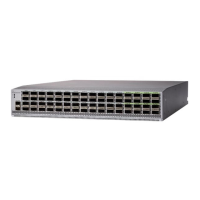

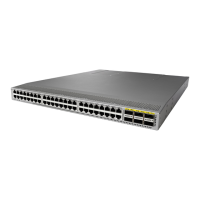
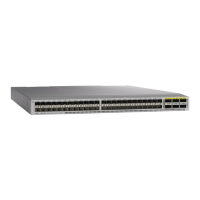


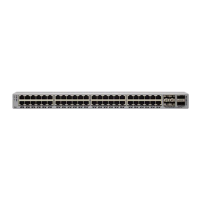

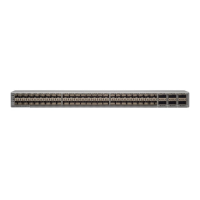
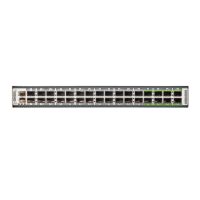
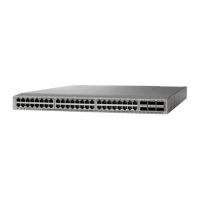
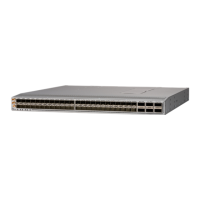
